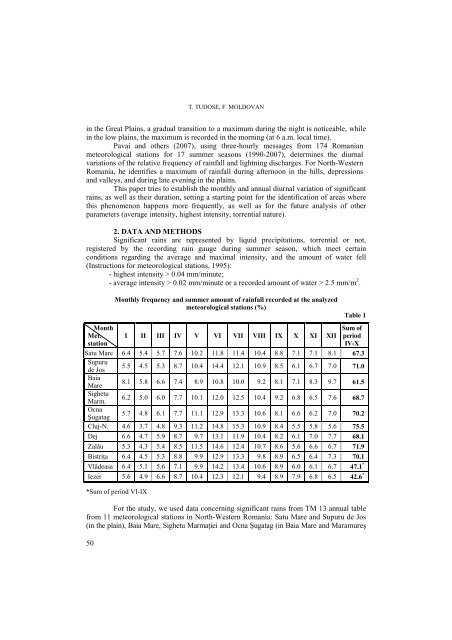geographia - Studia
geographia - Studia
geographia - Studia
Create successful ePaper yourself
Turn your PDF publications into a flip-book with our unique Google optimized e-Paper software.
T. TUDOSE, F. MOLDOVAN<br />
in the Great Plains, a gradual transition to a maximum during the night is noticeable, while<br />
in the low plains, the maximum is recorded in the morning (at 6 a.m. local time).<br />
Pavai and others (2007), using three-hourly messages from 174 Romanian<br />
meteorological stations for 17 summer seasons (1990-2007), determines the diurnal<br />
variations of the relative frequency of rainfall and lightning discharges. For North-Western<br />
Romania, he identifies a maximum of rainfall during afternoon in the hills, depressions<br />
and valleys, and during late evening in the plains.<br />
This paper tries to establish the monthly and annual diurnal variation of significant<br />
rains, as well as their duration, setting a starting point for the identification of areas where<br />
this phenomenon happens more frequently, as well as for the future analysis of other<br />
parameters (average intensity, highest intensity, torrential nature).<br />
2. DATA AND METHODS<br />
Significant rains are represented by liquid precipitations, torrential or not,<br />
registered by the recording rain gauge during summer season, which meet certain<br />
conditions regarding the average and maximal intensity, and the amount of water fell<br />
(Instructions for meteorological stations, 1995):<br />
- highest intensity > 0.04 mm/minute;<br />
- average intensity > 0.02 mm/minute or a recorded amount of water > 2.5 mm/m 2 .<br />
Month<br />
Met.<br />
station<br />
50<br />
Monthly frequency and summer amount of rainfall recorded at the analyzed<br />
meteorological stations (%)<br />
I II III IV V VI VII VIII IX X XI XII<br />
Table 1<br />
Sum of<br />
period<br />
IV-X<br />
Satu Mare 6.4 5.4 5.7 7.6 10.2 11.8 11.4 10.4 8.8 7.1 7.1 8.1 67.3<br />
Supuru<br />
de Jos<br />
5.5 4.5 5.3 8.7 10.4 14.4 12.1 10.9 8.5 6.1 6.7 7.0 71.0<br />
Baia<br />
Mare<br />
8.1 5.8 6.6 7.4 8.9 10.8 10.0 9.2 8.1 7.1 8.3 9.7 61.5<br />
Sighetu<br />
Marm.<br />
6.2 5.0 6.0 7.7 10.1 12.0 12.5 10.4 9.2 6.8 6.5 7.6 68.7<br />
Ocna<br />
Şugatag<br />
5.7 4.8 6.1 7.7 11.1 12.9 13.3 10.6 8.1 6.6 6.2 7.0 70.2<br />
Cluj-N. 4.6 3.7 4.8 9.3 11.2 14.8 15.3 10.9 8.4 5.5 5.8 5.6 75.5<br />
Dej 6.6 4.7 5.9 8.7 9.7 13.1 11.9 10.4 8.2 6.1 7.0 7.7 68.1<br />
Zalău 5.3 4.3 5.4 8.5 11.5 14.6 12.4 10.7 8.6 5.6 6.6 6.7 71.9<br />
BistriŃa 6.4 4.5 5.3 8.8 9.9 12.9 13.3 9.8 8.9 6.5 6.4 7.3 70.1<br />
Vlădeasa 6.4 5.1 5.6 7.1 9.9 14.2 13.4 10.6 8.9 6.0 6.1 6.7 47.1 *<br />
Iezer 5.6 4.9 6.6 8.7 10.4 12.3 12.1 9.4 8.9 7.9 6.8 6.5 42.6 *<br />
*Sum of period VI-IX<br />
For the study, we used data concerning significant rains from TM 13 annual table<br />
from 11 meteorological stations in North-Western Romania: Satu Mare and Supuru de Jos<br />
(in the plain), Baia Mare, Sighetu MarmaŃiei and Ocna Şugatag (in Baia Mare and Maramureş

















